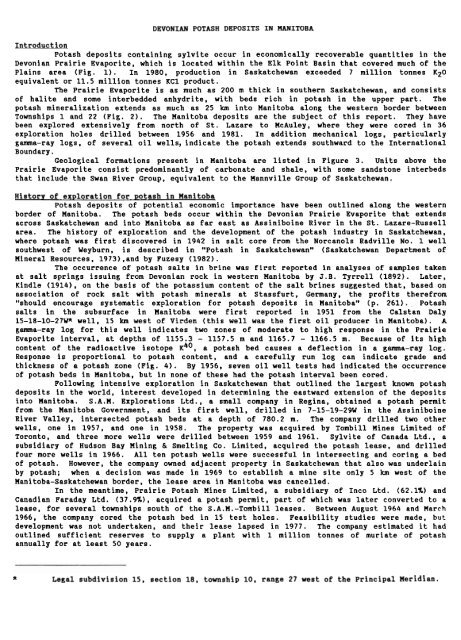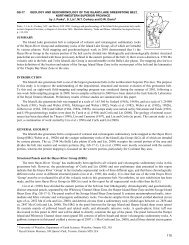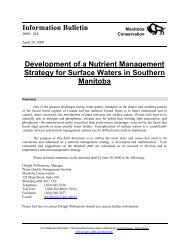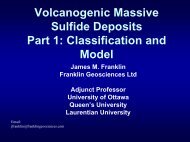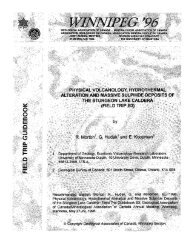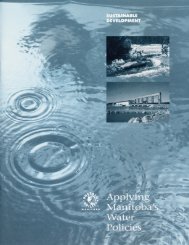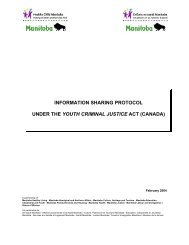Devonian Potash Deposits in Manitoba - Government of Manitoba
Devonian Potash Deposits in Manitoba - Government of Manitoba
Devonian Potash Deposits in Manitoba - Government of Manitoba
Create successful ePaper yourself
Turn your PDF publications into a flip-book with our unique Google optimized e-Paper software.
DEVONIAN POTASH DEPOSITS IN MANITOBAIntroduction<strong>Potash</strong> deposits conta<strong>in</strong><strong>in</strong>g sylvite occur <strong>in</strong> economically recoverable quantities <strong>in</strong> the<strong>Devonian</strong> Prairie Evaporite, which is located with<strong>in</strong> the Elk Po<strong>in</strong>t Bas<strong>in</strong> that covered much <strong>of</strong> thePla<strong>in</strong>s area (Fig. 1). In 1980, production <strong>in</strong> Saskatchewan exceeded 7 million tonnes K20equivalent or 11.5 million tonnes KC1 product.The Prairie Evaporite is as much as 200 m thick <strong>in</strong> southern Saskatchewan, and consists<strong>of</strong> halite and some <strong>in</strong>terbedded anhydrite, with beds rich <strong>in</strong> potash <strong>in</strong> the upper part. Thepotash m<strong>in</strong>eralization extends as much as 25 km <strong>in</strong>to <strong>Manitoba</strong> along the western border betweenTownships 1 and 22 (Fig. 2). The Hanitoba deposits are the subject <strong>of</strong> this report. They havebeen explored extensively from north <strong>of</strong> St. Lazare to McAuley, where they were cored <strong>in</strong> 36exploration holes drilled between 1956 and 1981. In addition mechanical logs, particularlygamma-ray logs, <strong>of</strong> several oil wells, <strong>in</strong>dicate the potash extends southward to the InternationalBoundary.Geological formations present <strong>in</strong> <strong>Manitoba</strong> are listed <strong>in</strong> Figure 3. Units above thePrairie Evaporite consist predom<strong>in</strong>antly <strong>of</strong> carbonate and shale, with some sandstone <strong>in</strong>terbedsthat <strong>in</strong>clude the Swan River Group, equivalent to the Mannville Group <strong>of</strong> Saskatchewan.History <strong>of</strong> exploration for potash <strong>in</strong> <strong>Manitoba</strong><strong>Potash</strong> deposits <strong>of</strong> potential economic importance have been outl<strong>in</strong>ed along the westernborder <strong>of</strong> <strong>Manitoba</strong>. The potash beds occur with<strong>in</strong> the <strong>Devonian</strong> Prairie Evaporite that extendsacross Saskatchewan and <strong>in</strong>to <strong>Manitoba</strong> as far east as Ass<strong>in</strong>ibo<strong>in</strong>e River <strong>in</strong> the St. Lazare-Russellarea. The history <strong>of</strong> exploration and the development <strong>of</strong> the potash <strong>in</strong>dustry <strong>in</strong> Saskatchewan,where potash was first discovered <strong>in</strong> 1942 <strong>in</strong> salt core from the Norcanols Radville No. 1 wellsouthwest <strong>of</strong> Weyburn, is described <strong>in</strong> "<strong>Potash</strong> <strong>in</strong> Saskatchewan" (Saskatchewan Department <strong>of</strong>M<strong>in</strong>eral Resources, 1973),and by Fuzesy (1982).The occurrence <strong>of</strong> potash salts <strong>in</strong> br<strong>in</strong>e was first reported <strong>in</strong> analyses <strong>of</strong> samples takenat salt spr<strong>in</strong>gs issu<strong>in</strong>g from <strong>Devonian</strong> rock <strong>in</strong> western <strong>Manitoba</strong> by J.B. Tyrrell (1892). Later,K<strong>in</strong>dle (1914), on the basis <strong>of</strong> the potassium content <strong>of</strong> the salt br<strong>in</strong>es suggested that, based onassociation <strong>of</strong> rock salt with potash m<strong>in</strong>erals at Stassfurt, Germany, the pr<strong>of</strong>its therefrom"should encourage systematic exploration for potash deposits <strong>in</strong> <strong>Manitoba</strong>" (p. 261). <strong>Potash</strong>salts <strong>in</strong> the subsurface <strong>in</strong> <strong>Manitoba</strong> were first reported <strong>in</strong> 1951 from the Calstan Daly15-18-10-27W well, 15 km west <strong>of</strong> Virden (this well was the first oil producer <strong>in</strong> <strong>Manitoba</strong>). Agamma-ray log for this well <strong>in</strong>dicates two zones <strong>of</strong> moderate to high response <strong>in</strong> the PrairieEvaporite <strong>in</strong>terval, at depths <strong>of</strong> 1155.3 - 1157.5 m and 1165.7 - 1166.5 m. Because <strong>of</strong> its highcontent <strong>of</strong> the radioactive isotope K~O, a potash bed causes a deflection <strong>in</strong> a gamma-ray log.Response is proportional to potash content, and a carefully run log can <strong>in</strong>dicate grade andthickness <strong>of</strong> a potash zone (Fig. 4). By 1956, seven oil well tests had <strong>in</strong>dicated the occurrence<strong>of</strong> potash beds <strong>in</strong> Hanitoba, but <strong>in</strong> none <strong>of</strong> these had the potash <strong>in</strong>terval been cored.Follow<strong>in</strong>g <strong>in</strong>tensive exploration <strong>in</strong> Saskatchewan that outl<strong>in</strong>ed the largest known potashdeposits <strong>in</strong> the world, <strong>in</strong>terest developed <strong>in</strong> determ<strong>in</strong><strong>in</strong>g the eastward extension <strong>of</strong> the deposits<strong>in</strong>to <strong>Manitoba</strong>. S.A.M. Explorations Ltd., a small company <strong>in</strong> Reg<strong>in</strong>a, obta<strong>in</strong>ed a potash permitfrom the <strong>Manitoba</strong> <strong>Government</strong>, and its first well, drilled <strong>in</strong> 7-15-19-29W <strong>in</strong> the Ass<strong>in</strong>ibo<strong>in</strong>eRiver Valley, <strong>in</strong>tersected potash beds at a depth <strong>of</strong> 780.2 m. The company drilled two otherwells, one <strong>in</strong> 1957, and one <strong>in</strong> 1958. The property was acquired by Tombill n<strong>in</strong>es Limited <strong>of</strong>Toronto, and three more wells were drilled between 1959 and 1961. Sylvite <strong>of</strong> Canada Ltd., asubsidiary <strong>of</strong> Hudson Bay M<strong>in</strong><strong>in</strong>g & Smelt<strong>in</strong>g Co. Limited, acquired the potash lease, and drilledfour more wells <strong>in</strong> 1966. All ten potash wells were successful <strong>in</strong> <strong>in</strong>tersect<strong>in</strong>g and cor<strong>in</strong>g a bed<strong>of</strong> potash. However, the company owned adjacent property <strong>in</strong> Saskatchewan that also was underla<strong>in</strong>by potash; when a decision was made <strong>in</strong> 1969 to establish a m<strong>in</strong>e site only 5 km west <strong>of</strong> the<strong>Manitoba</strong>-Saskatchewan border, the lease area <strong>in</strong> <strong>Manitoba</strong> was cancelled.In the meantime, Prairie <strong>Potash</strong> M<strong>in</strong>es Limited, a subsidiary <strong>of</strong> Inco Ltd. (62.1%) andCanadian Faraday Ltd. (37.973, acquired a potash permit, part <strong>of</strong> which was later converted to alease, for several townships south <strong>of</strong> the S.A.M.-Tombill leases. Between August 1964 and March1966, the company cored the potash bed <strong>in</strong> 15 test holes. Feasibility studies were made, butdevelopment was not undertaken, and their lease lapsed <strong>in</strong> 1977. The company estimated it hadoutl<strong>in</strong>ed sufficient reserves to supply a plant with 1 million tonnes <strong>of</strong> muriate <strong>of</strong> potashannually for at least 50 years.* Legal subdivision 15, section 18, township 10, range 27 west <strong>of</strong> the Pr<strong>in</strong>cipal Meridian.


